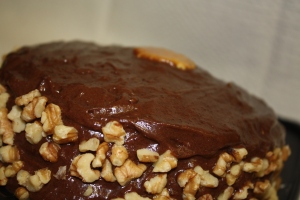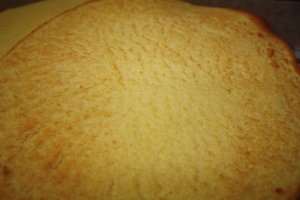
The August 2009 Daring Bakers’ challenge was hosted by Angela of A Spoonful of Sugar and Lorraine of Not Quite Nigella. They chose the spectacular Dobos Torte based on a recipe from Rick Rodgers’ cookbook Kaffeehaus: Exquisite Desserts from the Classic Caffés of Vienna, Budapest, and Prague.
For the Daring Baker’s August challenge we made a Dobo’s Torta, which is an Hungarian specialty. A Dobos Torta, or torte, is a multi-layer cake (most of the time 5 layers) that is filled with a rich, chocolate buttercream frosting then topped with thin layers of caramel. The cake is named after a well-known Hungarian baker, Jozsef C. Dobos, who invented the cake.
Here is a history of the torta:
“Dobosh or Dobos Torte (type of cake) was first introduced at the National General Exhibition of Budapest in 1885; Franz Joseph I and his Empress Elisabeth were among the first to taste it. The cake soon became popular throughout Europe as it was different from all others. It was simple but elegant, as opposed to the multi-storey, flaming cakes of the age. Its other secret was its use of fine buttercream, which was very little known at the time; cake fillings and frostings were usually made with cooked pastry cream or whipped cream. The chocolate buttercream and the batter of the cake were both invented by Jozsef C. Dobos.
Dobos travelled around Europe and introduced the cake wherever he went. For a long time he kept the exact recipe confidential, until 1906 when he retired and gave the original recipe to the Budapest Confectioners’ and Gingerbread Makers’ Chamber of Industry, providing that every member of the chamber can use it freely.
Dobos Torte is known everywhere in the world and there are more than one hundred recipe variations. It is a commonly made torte in the upscale hotels, restaurants and pastry shops of the world. Another famous Hungarian dessert created in the same era is Rigo Jancsi.”
Information source: Wikipedia
I always enjoy attempting to make things that are different and that I’ve never made before. That’s one of the many things about the daring bakers I like, I am always able to attempt new recipes and new methods of cooking. Since I have joined, my eyes have been opened to many new techniques and many new recipes. This month was no exception.
I have never made or attempted to make a sponge cake, so when I found out this challenge involved sponge cake I was pretty excited but I was also a little hesitant. After I read the recipe for the cake, the process sounded a little similar to a recipe that I attemped a while back that I did not have success with. So I wasn’t really sure if I was going to have success with this recipe or not.
For this being my first attempt at making a sponge cake I was pretty happy with the outcome. I’ve never worked with a cake batter that turned out to be the consistency of this batter. It was definitely a different experience. It was also neat being able to pour the batter and watch it stay in the same place your poured it, rather than it spreading all over the pan. I did learn from my experience this time and I will do a few things different next time, but all in all it was a good experience.
I did have a little problem with the caramel sauce, I couldn’t really get it to the consistency I wanted. After working with it for quite some time, I finally settled with the consistency and poured it over a layer of sponge cake. It set fairly quickly, and after comparing pictures from other posts I decided that mine looked very similar. The only thing with the caramel is that it tasted a lot like lemons. I used the right amount of lemon juice, so I’m not sure if the lemon taste was supposed to be that evident or of the juice was just extra strong. I didn’t want to ruin the taste of the cake and icing so I just put a little accent piece of the caramel topping on the cake.
I’m so happy I was able to attempt this recipe. I wouldn’t say it turned out perfect but I am happy at the results since it was my first time. I will probably try a recipe like this again and make a few changes to get the results I want.
Daring Bakers Dobo’s Torta
Sponge Cake:
6 large eggs, separated, at room temperature
1 1/3 cups confectioner’s sugar, divided
1 teaspoon vanilla extract
1 cup plus 2 tablespoons sifted cake flour
pinch of salt
Directions:
Place the racks in the top and centre of the oven and preheat oven to 400F.
Cut six pieces of parchment paper to fit the baking sheets. Use the bottom of a 9″ springform tin as a template and a dark pencil or a pen, trace a circle on each of the papers, and turn them over (the circle should be visible from the other side, so that the graphite or ink doesn’t touch the cake batter.)
Beat the egg yolks, 2/3 cup confectioner’s sugar, and the vanilla in a bowl on high speed until the mixture is thick, pale yellow and forms a thick ribbon when the beaters are lifted. Bean about 3 minutes. (You can do this step with a balloon whisk if you don’t have a mixer.)
In another bowl, using clean beaters, beat the egg whites until soft peaks form. Slowly add in the remaining 2/3 cup of confectioner’s sugar until the whites form stiff, shiny peaks. Using a large spatula, stir about 1/4 of the beaten whites into the egg yolk mixture, then fold in the remainder, leaving a few wisps of white visible. Combine the flour and salt. Sift half the flour over the eggs, and fold in; repeat with the remaining flour.
Line one of the baking sheets with a circle-marked paper. Using a small spatula, spread about 3/4cup of the batter in an even layer, filling in the traced circle on one baking sheet. Bake on the top rack for 5 minutes, until the cake springs back when pressed gently in the center and the edges are lightly browned.
While this cake bakes, repeat the process on the other baking sheet, placing it on the centre rack. When the first cake is done, move the second cake to the top rack. Invert the first cake onto a flat surface and carefully peel off the paper. Slide the cake layer back onto the paper and let stand until cool.
Rinse the baking sheet under cold running water to cool, and dry it before lining with another parchment. Continue with the remaining papers and batter to make a total of six layers. Completely cool the layers. Using an 8″ springform pan bottom or plate as a template, trim each cake layer into a neat round. (A small serrated knife is best for this task.)
Sponge Cake Layer
Chocolate Buttercream Frosting:
Ingredients:
4 large eggs, at room temperature
1 cup caster (ultrafine or superfine white) sugar
4oz bakers chocolate or your favourite dark chocolate, finely chopped
2 sticks plus 2 tablespoons unsalted butter, at room temperature.
Directions:
Prepare a double-boiler: fill a large saucepan a quarter full with water and bring it to a boil.
In a separate bowl (heat safe), whisk the eggs with the sugar until pale and thickened, about five minutes. You can use a balloon whisk or electric hand mixer for this.
Fit bowl over the boiling water in the saucepan (water should not touch bowl) and lower the heat to a brisk simmer. Cook the egg mixture, whisking constantly, for 2-3 minutes until you see it starting to thicken. Whisk in the chocolate and cook, stirring, for a further 2-3 minutes.
Scrape the chocolate mixture into a medium bowl and leave to cool to room temperature. It should be quite thick and sticky in consistency.
When cool, beat in the soft butter, a small piece at a time. An electric hand mixer is great here, but it is possible to beat the butter in with a spatula if it is soft enough. You should end up with a thick, velvety chocolate buttercream. Chill while you make the caramel topping.
Caramel Topping
Ingredients:
1 cup caster (superfine or ultrafine white) sugar
Choose the best-looking cake layer for the caramel top.
12 tablespoons water
8 teaspoons lemon juice
1 tablespoon neutral oil (e.g. grapeseed, rice bran, sunflower)
Directions:
To make the caramel topping: Line a jellyroll pan with parchment paper and butter the paper. Place the reserved cake layer on the paper. Score the cake into 12 equal wedges. Lightly oil a thin, sharp knife and an offset metal spatula.
Stir the sugar, water and lemon juice in a small saucepan. Bring to a boil over a medium heat, stirring often to dissolve the sugar. Once dissolved into a smooth syrup, turn the heat up to high and boil without stirring, swirling the pan by the handle occasionally and washing down any sugar crystals on the sides of the pan with a wet brush until the syrup has turned into an amber-coloured caramel.
Immediately pour all of the hot caramel over the cake layer.
***There will have some leftover most probably but more is better than less and you can always make nice toffee pattern using the extra to decorate. Using the offset spatula, quickly spread the caramel evenly to the edge of the cake layer. Let cool until beginning to set, about 30 seconds. Using the tip of the hot oiled knife (keep re-oiling this with a pastry brush between cutting), cut through the scored marks to divide the caramel layer into 12 equal wedges. Cool another minute or so, then use the edge of the knife to completely cut and separate the wedges using one firm slice movement (rather than rocking back and forth which may produce toffee strands). Cool completely.
Assembling the Dobos
Divide the buttercream into six equal parts.
Place a dab of chocolate buttercream on the middle of a cake base and top with one cake layer. Spread the layer with one part of the chocolate icing. Repeat with 4 more cake layers. Spread the remaining icing on the sides of the cake.
Optional: press the finely chopped hazelnuts onto the sides of the cake.
Propping a hazelnut under each wedge so that it sits at an angle, arrange the wedges on top of the cake in a spoke pattern. If you have any leftover buttercream, you can pipe rosettes under each hazelnut or a large rosette in the centre of the cake. Refrigerate the cake under a cake dome until the icing is set, about 2 hours. Let slices come to room temperature for the best possible flavour.
Variations:
Shape: The traditional shape of a Dobos Torta is a circular cake, but you can vary the shape and size if you want. Sherry Yard in Desserts By The Yard makes a skyscraper Dobos by cutting a full-size cake into four wedges and stacking them to create a tall, sail-shaped cake. Mini Dobos would be very cute, and you could perch a little disc of caramel on top.
Flavour: While we both love the dark chocolate buttercream and this is traditional, we think it would be fun to see what fun buttercreams you all come up with! So, go wild! Or, you could brush each layer with a flavoured syrup if you just want a hint of a second flavour. Cointreau syrup would be divine!
Nuts: These are optional for decoration, so no worries if you’re allergic to them. If you don’t like hazelnuts, then substitute for another variety that you like.
Egg concerns
The cooking process for the buttercream will produce lightly cooked eggs. If you fall into a vulnerable health group then you may wish to use an egg-less buttercream.
Resources
http://cafechocolada.blogspot.com/2008/04/dobos-torte.html
http://books.google.co.uk/books?id=4VHMjIfxfYcC&pg=PA240&lpg=PA240&dq=%22dobos+torte%22&source=bl&ots=tcE2j8dTLl&sig=QoPANOL_MJnfi_vmHm5rW2ncC60&hl=en&ei=jidySrbpKeG2jAec58mODA&sa=X&oi=book_result&ct=result&resnum=7
http://paulaerbay2.wordpress.com/2007/07/24/dobos-torte-recipe/
Leave a Reply